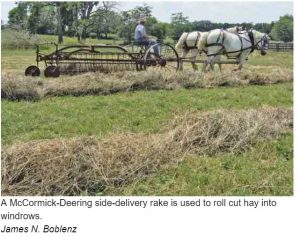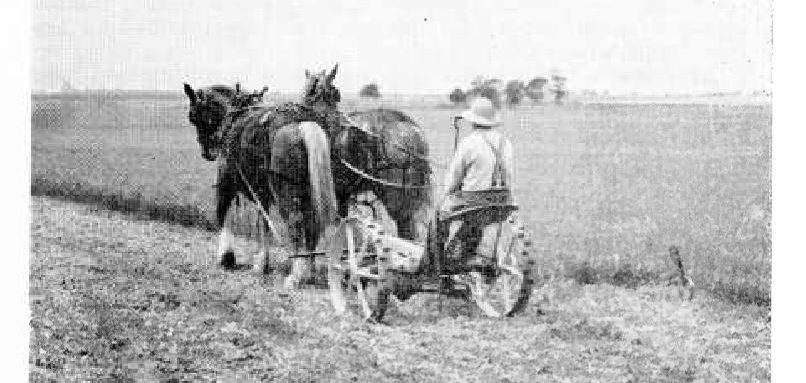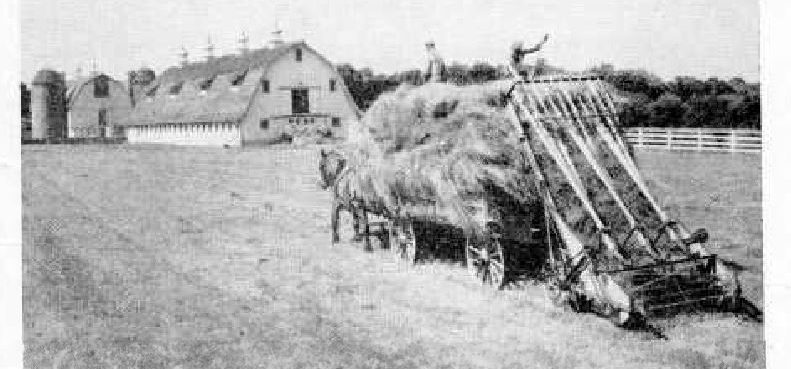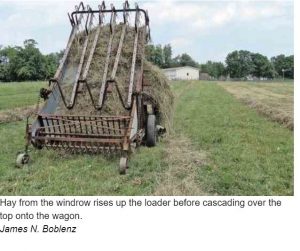
Make Hay while the Sun Shines
Hay making requires several days of good weather. Hay must be quite dry before storing it in a barn as it will mold heat up and can cause spontaneous combustion-burning the barn to the ground.

Horse Drawn Mower
Typical horse drawn mower. Mower had a 5 foot swath

Loading loose hay
Typical hay wagon and farmers loading loose hay. Some worried about snakes coming up the loader.

It’s time to make hay
For mid-west Dairy farms, hay making was one of the time-consuming processes, but one that I remember as more fun than some others. The smell of new hay is pleasant and unique. Building a load was somewhat of an art. The object was to spread the hay on the wagon bed so it clung to the wagon even after it was 8 or 10 feet from the bed and getting it to the barn without upsetting it.
Hay was the bulk of our cattle’s diets through the winter months. It was always available to them, although they also were given silage (fermented corn foliage) and some ground grains twice a day which they munched on while in their stanchions for milking.
Hay was mostly timothy with a little clover mixed in. Timothy seeds were usually planted with fall wheat but could be over-seeded in the spring as the winter wheat was greening after the winter cold. The timothy remained dormant until the wheat was harvested and then it took over the field. The first hay crop came the following summer but could be harvested for one or two years more.
Beginning in mid-June, the hay could be cut. We used a horse drawn mower that had a 5 foot long blade. While the field was wet with dew, we would sharpen the blade segments. Once the dew had evaporated, we could cut the hay, attempting to find the weather with us so it had 2 or 3 days without rain.
After the hay had dried, usually 3 days after it was mowed, it was time to load it on a hay wagon and bring it into the barn. We could normally pick it up with the hay loader without raking it, but if it had been rained on or was light, we could rake it into windrows.
The hay loader was a series of long slats with hinged rakes to push the hay to the top of the load. We used a horse driven wagon with the hay loader attached to the back. The loader had large wheels that turned rakes that picked up the hay and pushed it into a zone where the slats up and down motion to move it to the top of the load. Usually two men with 3 pronged hay forks positioned the hay on the wagon to build a nice even load. Properly loaded, the hay could be piled about 8 to 10 feet high.
Once loaded, it was taken up the ramp to the barn floor. The barn was equipped with an iron track that ran along the roofline. A gadget rolled freely on that track except for a spot directly in the center of the roofline, where a latch held it in place. A 1 inch manila rope went from that gadget to a hay fork, back to the gadget, then to the end of the hay mow, then to pulleys that could be attached to a horse double tree. The fork was forced into the hay and then was set with prongs so a portion of the hay would attach to the fork. A 3/8 inch rope was attached to the fork and ran through the gadget on the tracks. By this arrangement, a large part of the had was lifted to the top of the barn. When the fork reached the gadget at the top, it released and moved to the middle of the mow. The small rope was pulled tripping the fork prongs and the hay was dropped in the mow. Another man in the mow distributed the hay. The process was repeated until the load was empty. The wagon was pushed out of the barn, down the hill and we could take it to the field for another load.
We owned a tedder, but It was only needed it the hay had been subjected to heavy rain and was matted down so it could not dry properly. We normally could pick days when rain was not likely. Hay must be quite dry before packing it into the barn. If too damp, it will begin to mildew, which in turn supports bacteria growth. The decaying hay can become so hot that it will spontaneously begin to burn and this was the source of some barn fires.
In the 1940’s hay bailers that could pick up hay and bail it in the fields became more common, and within a decade or so, most had was bailed in the field, and the bails were stored in the hay mows..”